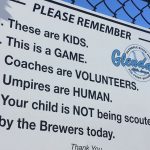Measuring Baseball: Irrelevant Statistics Take Center Stage
 Listen to a baseball game on radio, or watch it on television. Prepare to be barraged by numbers. Measurements. Not batting average or on-base percentage, home runs or runs batted in or even the newest stat, OPS (on-base plus slugging). Sabermetrics is not the culprit, because it is not usually discussed on baseball broadcasts. Too esoteric.
Listen to a baseball game on radio, or watch it on television. Prepare to be barraged by numbers. Measurements. Not batting average or on-base percentage, home runs or runs batted in or even the newest stat, OPS (on-base plus slugging). Sabermetrics is not the culprit, because it is not usually discussed on baseball broadcasts. Too esoteric.
Measurements of balls thrown and hit are now recorded on almost every play. Speed. Velocity. Launch angle. Measurements of baseball accomplishments that validate them, as if they needed validation to be real.
It’s as though it’s no longer enough to see a play. Only the numbers make it real. Only the numbers make the game mean more than it does.
When Numbers Mean Nothing
For example, watching a New York Yankees game the other day, Michael Kay, the Yankees announcer, said Yankees pitchers, over their last five starts, had struck out more than eight men in each start. The most since 1908. He mused on that coincidence a moment, as if somehow this fact changed the Yankees chances for a World Series appearance. But what did it mean?
Random accomplishments occur without any specific reason. And in an age when everyone seems to be striking out, what was really unusual was five pitchers hadn’t struck out more than eight men in five consecutive starts in 110 years. But, did it say anything about that game? No.
In many ways, baseball’s become like a sneaker store. There are hundreds of pairs of sneakers. Walking in is befuddling. How to choose? This one, that one? And as I watch a baseball game now, I’m barraged by statistics, and ads to buy this beer or that car or office goods from this stationery business. Hardly a moment goes by when some product is not being hawked. Or a number is validating a play.
Put on a baseball game and numbers come at you hot and heavy. The unspoken assumption is everything that happens in a game is connected to what has happened before, and it may suggest what will happen again. Even if what is referred to means very little in the context of the game.
Perhaps baseball produces so many statistics because facts and figures have become so easy to find and correlate in high-speed computer systems. It’s easier to fill broadcasts with scripted numbers than unscripted baseball conversation that sometimes gets announcers in trouble. Especially when chatter must fit in between pitches, and those short 15-second ads that affect the rhythms of game description.
Velo and Launch Angle
Years ago, there weren’t advertisements linked to every graphic flashed on the screen. From XYZ game weather reports to the game line score tucked into a different format with XYZ on its top line. Or the XYZ trivia question. And then there are 15-second voiceover ads attached to game events, like the XYZ call to the bullpen or the newest speed data graphics to remind the viewer how fast the pitcher is throwing. Or the “velo,” the velocity (a new baseball buzzword) on the last home run, shown along with the “launch angle” and distance the ball traveled. Home runs by themselves are no longer enough.
Baseball, by itself, without oodles of numbers, is a system of meaning. It’s a game within a game. The way hitters approach a pitcher. Or why a pitcher so dominates hitters. Statistics weren’t necessary to support Sandy Koufax’s dominance, or Tom Seaver’s mastery. Eyeballs were enough.
Seaver referred to “location, velocity and movement” when he spoke about pitching. Yet today, the emphasis is on cracking 100. Radar guns. The unspoken truth today is the game’s no longer enough to capture the attention of the viewing public, so bells and whistles are pasted over play. Measurements are the rage.
Impressions require a statistic to validate them. Otherwise, what have we seen? And the statistic invariably is sponsored. Yet another chance to make money organically within the broadcast.
The other night, the announcers of a game trumpeted a player’s near-record on-base-streak (something like 45 games in a row?) as if it meant anything other than the player, who already had an on-base-percentage over .400 (which meant he was on-base a lot), was getting on base a lot. It was not related to the team’s winning percentage or how the player contributes to the team’s success. It was presented as a stand-alone fact. The batter gets on base a lot. But facts can’t stand-alone. They need context. Otherwise, why do they matter?
The Good Ol’ Days
Baseball has become a slow death by statistical strangulation. Broadcasts of games once were like a magazine story. The focus was the game. Painting its actions. A chance to listen to a few narrative stories about yesterday. Then an ad. Then more of the human side of the game. A leisurely back and forth between announcers when more than one was in the booth. That’s almost passé today because of the sense of urgency.
There’s a scoring graphic in the corner of the screen. The score. The inning. Outs. Runners on base. Pitch count. Pitch speed. And then there’s the strike zone superimposed on the screen. The umpire’s call is no longer enough even if balls and strikes are subjective calls. Now, each one can be graphically challenged by broadcasters (even if ball and strike calls are not reviewable by managers). Managers still challenge calls from the dugout, until the challenge is too loud and crosses the line causing an ejection by the home plate umpire.
Years ago, managers were allowed to question interpretations of the strike zone, which led to memorable arguments between umpires and nemeses like Billy Martin, Earl Weaver, Lou Piniella, Tommy Lasorda, Leo Durocher and many others. That baseball inhibits managers from such lurid spectacles today is a shame. They were colorful inserts into a game. Moments of great theater that fans couldn’t take their eyes off. I miss them.
Maybe baseball needs to step back and look into its glorious past to find its future?

























